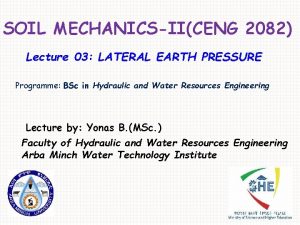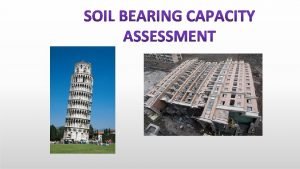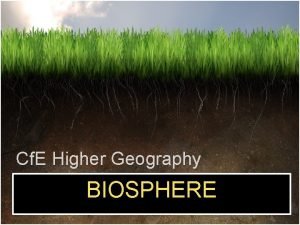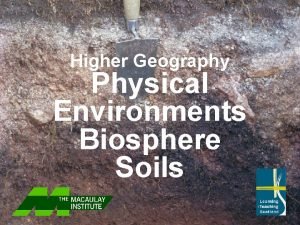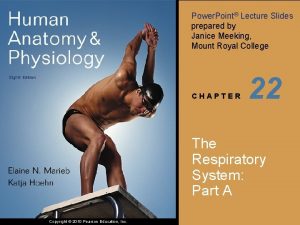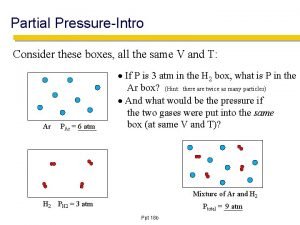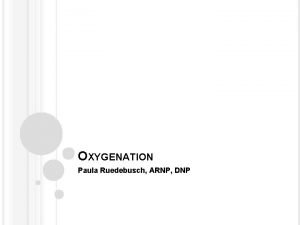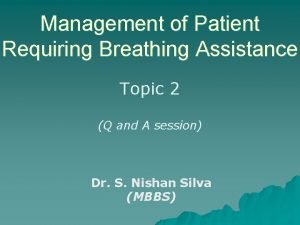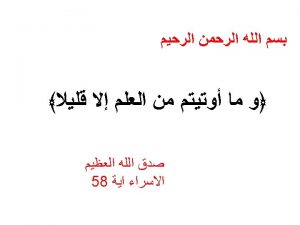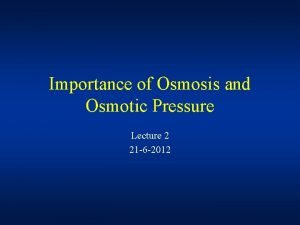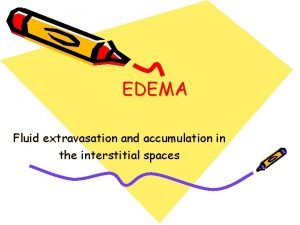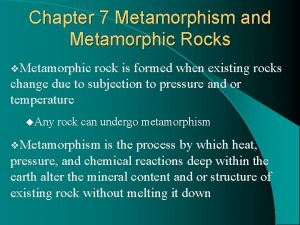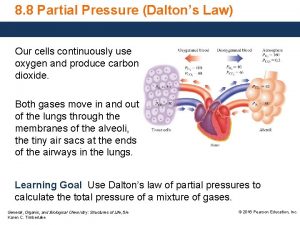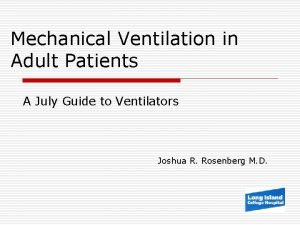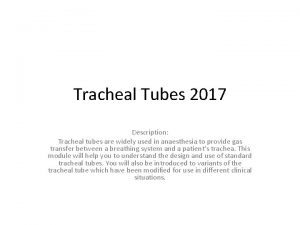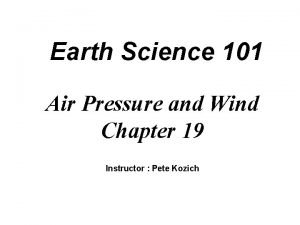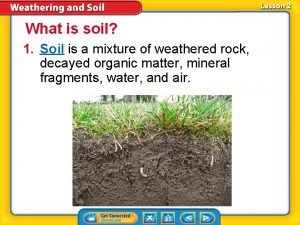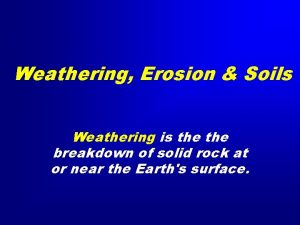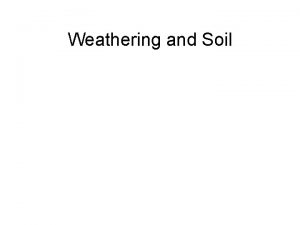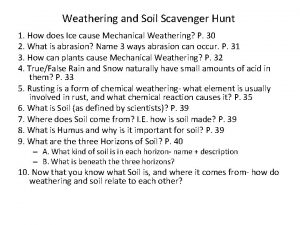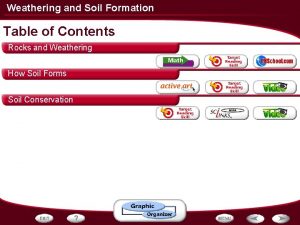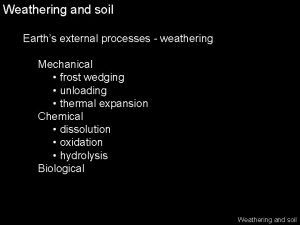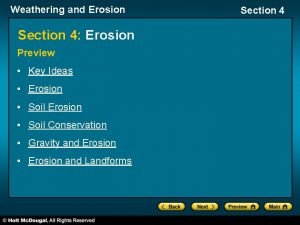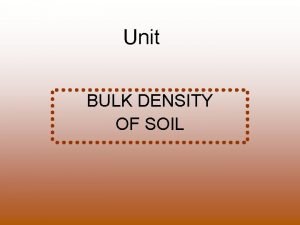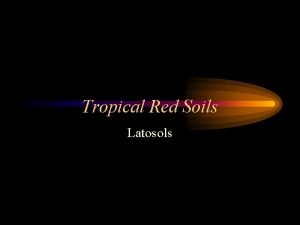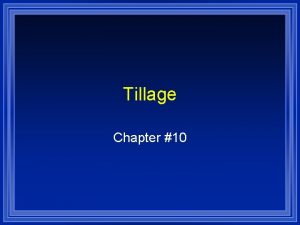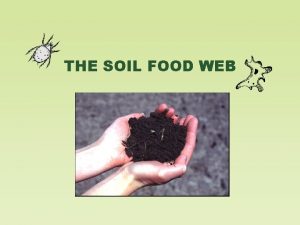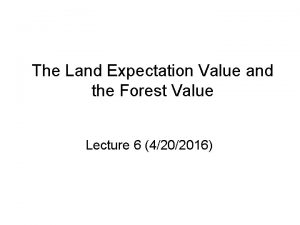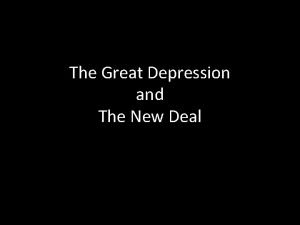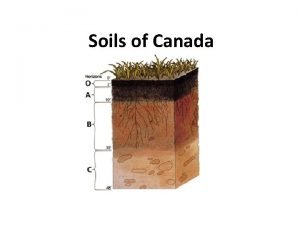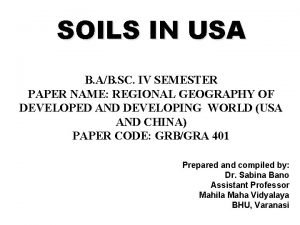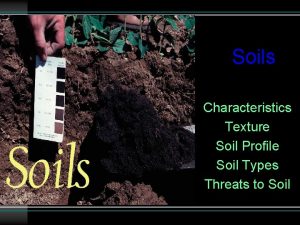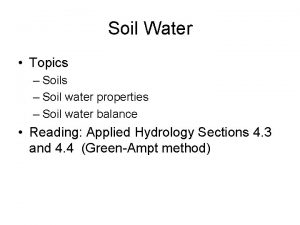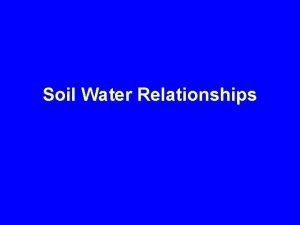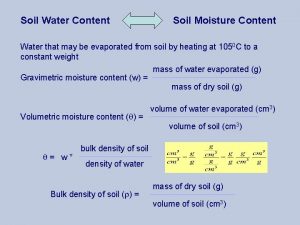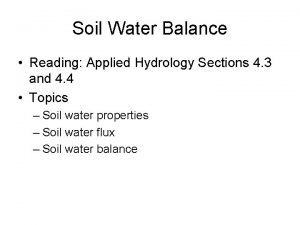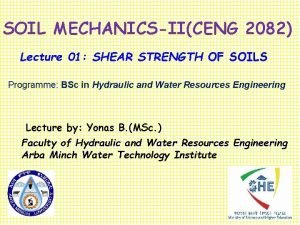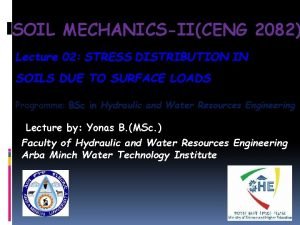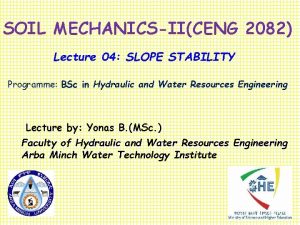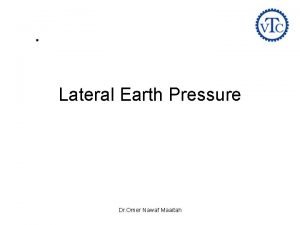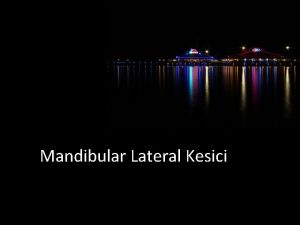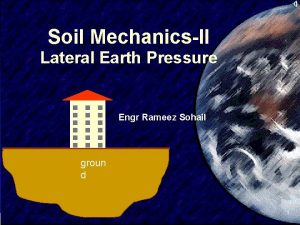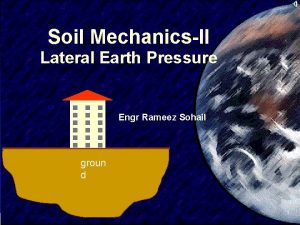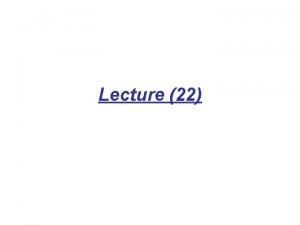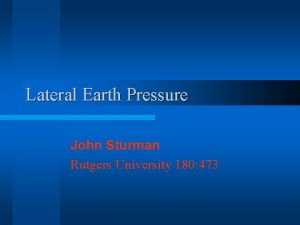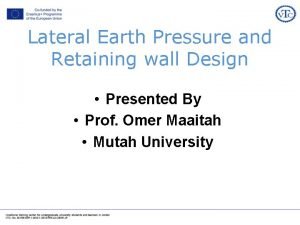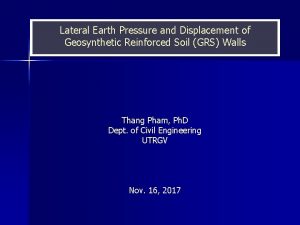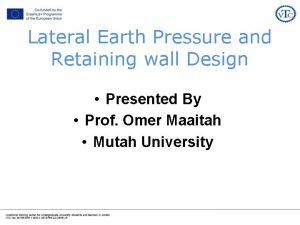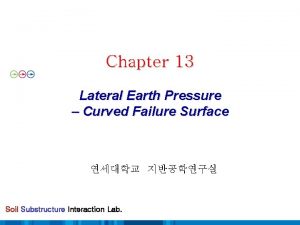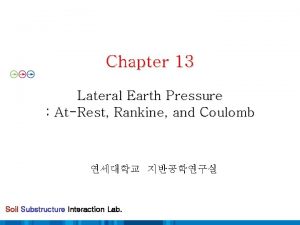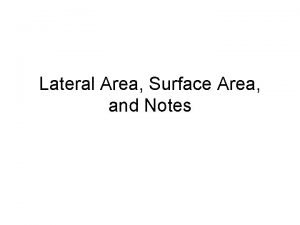SOIL MECHANICSIICENG 2082 Lecture 03 LATERAL EARTH PRESSURE



























































- Slides: 59

SOIL MECHANICS-II(CENG 2082) Lecture 03: LATERAL EARTH PRESSURE Programme: BSc in Hydraulic and Water Resources Engineering Lecture by: Yonas B. (MSc. ) Faculty of Hydraulic and Water Resources Engineering Arba Minch Water Technology Institute

Objectives § Understand lateral earth pressure. § Determine lateral earth pressure. By Defau K. (Msc) 2

CHAPTER OUTLINES ü 3. 1 Introduction ü 3. 2 Definitions ü 3. 3 Lateral Earth Pressure( At Rest, Active And Passive) ü 3. 4 Rankine’s Lateral Earth Pressure theory ü 3. 5 Coulomb’s Lateral Earth Pressure theory 3

3. 1 Introduction… Ø Vertical slopes of soil are supported by retaining walls, cantilever sheet pile walls, sheet pile bulkheads, bracedcuts, and other, similar structures. Ø Lateral earth pressure is lateral stress from soil laterally on soil retaining structures. Ø Retaining structures may be classified as : Ø Retaining walls Ø Sheet-pile bulkheads Ø Braced cuts Ø The proper design of these structures requires estimation of lateral earth pressure (LEP). 4

3. 1 Introduction… Lateral Earth Pressure ? ? (R. P. Weber) 5

3. 1 Introduction… Ø A retaining wall is a structure that is used to support a vertical or near vertical slopes of soil. The resulting horizontal stress from the soil on the wall is called lateral earth pressure. Ø To determine the magnitude of the lateral earth pressure, a geotechnical engineer must know the basic soil parameters – that is, unit weight , angle of friction , and cohesion c – for the soil retained behind the wall. Ø In the evaluation of the magnitude of this lateral earth pressure, it is assumed that the soil behind the wall (called backfill soil) is on the verge of failure and obeys some failure criterion, for example, the Mohr-Coulomb failure criterion. 6

3. 1 Introduction … Ø LEP is a function of several factors, including the following: Ø The type & amount of wall movement Ø Type of backfill used Ø The effective unit weight of the backfill soil, Ø Ground water position Ø The drainage condition in the backfill Ø Ground Surcharge Ø Surcharge application 7

3. 2 Definitions Ø Backfill: is soil at back of retaining structures, which can develop LEP. This soil in practically, granular, but sometimes may be C-pa soil. Ø At rest earth pressure coefficient (k 0) is the ratio between the lateral and vertical principal effective stresses when an earth retaining structure is at rest (or is not allowed to move at all). Ø Active earth pressure coefficient (ka) is the ratio between the lateral and vertical principal effective stresses when an earth retaining structure moves away from the retained soil. Ø Passive earth pressure coefficient (kp) is the ratio between the lateral and vertical principal effective stresses when an earth retaining structure is forced to move against a soil mass. 8

3. 3 Lateral Eath Pressure( At Rest, Active And Passive) Three Types of LEP i. PRESSURE AT REST-If the wall restrained/Fixed from moving – the LEP at any depth is referred to as earth pressure at-rest ii. ACTIVE EARTH PRESSURE-If the wall tilts away from the retained soil – Active earth pressure. iii. PASSIVE EARTH PRESSURE- If the wall is pushed into the retained soil – Passive earth pressure. 9

Type of lateral Earth pressure developed on retaining walls : (a)at rest, (b)active&(c)passive 10

I. At Rest Earth Pressure Ø If the wall is rigid and does not move with the pressure exerted on the wall, the soil behind the wall will be in a state of elastic equilibrium. Consider a prismatic element E in the backfill at depth z shown in Fig. Where: Ko is the “at rest” earth pressure coefficient 11

I. LEP at-rest ü If the wall is at rest and is not allowed to move at all, either from the soil mass or into the soil mass (i. e. , there is zero horizontal strain), the lateral pressure at a depth Z is: But for φ soils; Without GWT If GWT is there But for C- φ soils; ho = Ko γH – 2 c (Ko)1/2 Where u = pore water pressure Ko = Coefficient of at-rest earth pressure 12

LEP at-rest …. Jacky eqn-For coarse material/NC soils For overconsolidated ü The total force Po, per unit length of the wall can be calculated from the pressure diagram as: üBased on experiments, the typical value of K 0 is about 0. 40 – 0. 50 for sand, 0. 35 – 0. 70 for normally consolidated clay, and 0. 50 – 3. 00 for overconsolidated soil. ü Where ϕ’ is the effective angle of internal friction of the soil. another formula is proposed by Brooker and Ireland (1965) for normally consolidated clay: 13

CONT… ü Empirical correlation between the coefficient of lateral earth pressure K 0 and the plasticity of normally consolidated clay is proposed by Alpan (1967) ü Where PI is the plasticity index of the soil. other empirical correlations were proposed by Mayne and Kulhawy (1982) 14

3. 3. Active and Passive Lateral Earth Pressures ü Failure of the backfill soil occurs by two mechanisms depending on the direction of wall displacement. ü If the displacement of the wall is away from the backfill soil the resulting failure is called active and the lateral pressure exerted on the wall by the backfill soil is called active lateral earth pressure. ü A passive failure occurs if the wall is displaced towards the backfill soil until the limiting displacement is achieved. the passive resistance provided by the backfill soil against the wall displacement is called passive earth pressure. ü In the next sections, we will deal with two active and passive earth pressure theories: one proposed by Rankine (1857) and the other by Coulomb (1776). 15

3. 3. 1 Rankine’s Active and passive Theory üConsider a vertical frictionless (smooth) wall retaining a soil mass in both front and back of the wall; vertical walls only For cohesive backfill ü For lateral earth pressure (active) : 16

RANKINE ACTIVE EARTH PRESSURE chapter 1; Mohr 3 = 1. tan 2 (45 - /2)-2 c. tan (45 - /2) From coulomb theory a = v. tan 2 (45 - /2)-2 c. tan (45 - /2) a = v. Ka – 2 c Ka for C- ɸ soils Ka = tan 2 (45 - /2) Tension zone 17

ACTIVE EARTH PRESSURE Note : z = 0 v = 0 ; a = -2 c Ka z = H v = H ü The tensile stress decreases with depth and becomes zero at a depth z = zc or zc. Ka – 2 c Ka = 0 and zc = depth of tensile crack For undrained condition 18

19

By Defau K. (Msc) 20

21

22

By Defau K. (Msc) 23

24

coefficient of active earth pressure, Ka i) *** Normally (i) and (ii) use for horizontal backfill while (iii) use for sloping backfill. ii) iii) Lateral soil pressure, a = Ka H for non-cohesive Resultant force per unit length of wall, Pa = ½ Ka H 2 for non-cohesive 25

EXAMPLE ACTIVE LEP Calculate the Rankine active force per unit length of the wall shown below, and also determine the location of the resultant. γ=15. 7 k. N/m 3 5 m Φ’=30 c’=0 Ans : Pa = 65. 4 k. N/m , y = 1. 67 m 26

3. 3. 2 RANKIN’S PASSIVE CONDITION ü For total passive pressure for non cohesive soils: ü For total passive pressure for cohesive soils/C- φ soils : K a < K 0< K p 27

3. 3. 2 RANKIN’S PASSIVE CONDITION WITH COHESIVE BACKFILL • For lateral earth pressure (passive) : 28

coefficient of passive earth pressure, Kp i) ii) *** Normally (i) and (ii) use for horizontal backfill while (iii) use for sloping backfill. iii) 29

EXAMPLE PASSIVE LEP ü For the retaining wall considered below, what is the Rankine passive force per unit length of the wall? γ=15. 7 k. N/m 3 5 m Φ’=30 c’=0 Ans : Pp = 588. 75 k. N/m , y = 1. 67 m 30

Active Earth Pressure- Backfill Soil Submerged ü If backfill is affected by GWT, its effect is considered during determination of LEP 31

Example Forces( area of LEP diagram) Location of resultant active force

Example 2(Layered soils) From the following retaining wall having backfill soil profile, determine lateral earth pressure and force with its point of h=5 m h 2 =3 m h 1 =2 m action. A 1=17 k. N/m 3 c 1=0 B 1=34 o 2=19 k. N/m 3 c 2=10 k. Pa 2=16 o C Ka 1=0. 283 calculated Ka 2=0. 57 calculated

Ka 1=0. 306 h=5 m h 1=2 m h 2=3 m Solution: Ka 2=0. 283 Horizontal stresses at each points as follows: A B 10. 4 k. P a 4. 2 k. Pa Is just above point B. C Is just Below point B. Total horizontal force: 36. 6 k. P a

WORK EXAMPLE 4 Determine the active force per unit length of the wall for Rankine state. Also find the location of the resultant. γ = 16 k. N/m 3 3 m Φ’ = 30 c’ = 0 GWT γsat = 18 k. N/m 3 Φ’ = 30 c’ = 0 3 m z Ans : Pa = 128. 394 k. N/m , y = 1. 78 m

Lateral Earth Pressure due to Surcharge For φ soils; 36

Active LEP-Backfill Soil Partly Submerged 37

Active Earth Pressure-Backfill Soil Partly Submerged & Uniformly Surcharge Load

For C- φ soils; 39

Active Earth Pressure-Backfill Soil Partly Submerged & Uniformly Surcharge Load 40

41

42

43

44

WORK EXAMPLE 5 Ø A frictionless retaining wall is shown below, find the passive resistance (Pp) on the backfill, and the location of the resultant passive force. q=10 k. N/m 2 γ=15 k. N/m 3 4 m Φ=26 c’=8 k. N/m 2 Ans : Pp = 512 k. N/m , y = 1. 0 m

SLOPING SURFACE-ACTIVE EARTH PRESSURE

SLOPING SURFACE-PASSIVE EARTH PRESSURE

3. 3. 2 Coulomb’s Earth Pressure Theory ü As described in the previous sections, the Rankine earth pressure theory: (1) assumes the retaining wall is frictionless (or smooth), and (2) considers stress states and uses such tools as the Mohr’s circle of stress. ü Coulomb (1776) proposed a theory to determine the lateral earth pressure on a retaining wall by assuming a granular backfill (c = 0) and a plane sliding surface. He account for the effects of friction (usually expressed by angle ) between the backfill and the wall. ü Besides, he considered the more general case of the sloped face of a retaining wall, and in this respect, Coulomb’s theory is a more general approach than the Rankine theory described earlier. 48

COULOMB'S EARTH PRESSURE THEORY Ø Coulomb made the following assumptions in the development of his theory: Ø 1. The soil is isotropic and homogeneous Ø 2. The rupture surface is a plane surface Ø 3. The failure wedge is a rigid body Ø 4. The pressure surface is a plane surface Ø 5. There is wall friction on the pressure surface Ø 6. Failure is two-dimensional and Ø 7. The soil is cohesionless 49

Cont… Figure 3. 8: Direction of active and passive forces when wall friction is present. 50

CONT…. ü Coulomb assumed a wedge shape collapse mechanism which is bounded by the face of the retaining wall, a horizontal or inclined ground surface and a linear failure plane. ü The wedge slides downwards on the failure plane in the active state or upwards in the passive state. ü Figure 3. 8 illustrates direction of active and passive forces when wall friction is present. 51

Coulomb’s Active earth pressure at sloped fill kac is Coulomb’s active pressure coefficient Figure 3. 9: Retaining wall with slopping back, wall friction, and sloping soil surface for use with Coulomb’s method for active state. 52

Cont … ü Note that the line of action of the active force Pa will act at a distance H/3 above the base of the wall and will be inclined at angle б to the normal drawn to the back of the wall. ü In the actual design of retaining walls, the б value of the wall friction angle, φ/2 , is assumed to be between 2φ/3 and. 53

Coulomb’s passive earth pressure at sloped fill Figure 3. 10: Retaining wall with slopping back, wall friction, and sloping soil surface for use with Coulomb’s method for passive state. 54

EXAMPLE 3. 5 ü What is the total active force per meter of wall for the soil-wall system, shown in Fig. E 3. 5 using the Coulomb equation? Where does Pa act? 55

Solution 4. 5 • Assume frictional angle b/n wall and soil φ/2 to 2φ/3; taking б= φ/2 the soil-wall Kac= 0. 343 56

Solution cont… • 57

References: 1. Das, Braja, Principles of Geotechnical Engineering, 5 th ed. , Brooks/Cole, 2002. 2. Budhu M. (2000), Soil Mechanics and Foundations, Wiley and Sons. 3. Lambe, T. W. , Whitman, R. V. (1999), Soil Mechanics, John Wiley & Sons Inc. 4. Teferra, A. & Mesfin, L. , Soil Mechanics, AAU 5. Craig, R. F. (2004), Craig's Soil Mechanics, 7 th edition, Taylor & Francis. 6. Bowles, J. E. , 1996. Foundation Analysis and Design, Joseph E. Bowles, Mc. Graw-Hill. 58

Thank you 59
 Lateral earth pressure شرح
Lateral earth pressure شرح K active soil
K active soil Passive earth pressure formula
Passive earth pressure formula Living soil vs dead soil
Living soil vs dead soil Four major spheres of the earth
Four major spheres of the earth 01:640:244 lecture notes - lecture 15: plat, idah, farad
01:640:244 lecture notes - lecture 15: plat, idah, farad Lateral surface area formulas
Lateral surface area formulas Boussinesq stress distribution
Boussinesq stress distribution The gross pressure intensity of structure is
The gross pressure intensity of structure is What is the
What is the Brown earth soil profile
Brown earth soil profile Podzol soil profile
Podzol soil profile Gley soil diagram
Gley soil diagram Vmo advancement cpt
Vmo advancement cpt Pressure support vs pressure control
Pressure support vs pressure control Continuous bedside pressure mapping
Continuous bedside pressure mapping Intrapulmonary pressure vs intrapleural pressure
Intrapulmonary pressure vs intrapleural pressure Starling forces equation
Starling forces equation Partial pressure formula
Partial pressure formula Transpulmonary pressure meaning
Transpulmonary pressure meaning Regional metamorphism
Regional metamorphism ütube
ütube Static pressure and dynamic pressure
Static pressure and dynamic pressure Afferent and efferent arterioles
Afferent and efferent arterioles Oncotic pressure
Oncotic pressure Is oncotic pressure the same as osmotic pressure
Is oncotic pressure the same as osmotic pressure Hydrostatic oncotic pressure
Hydrostatic oncotic pressure Metamorphism
Metamorphism Blood pressure regulation
Blood pressure regulation How to find partial pressure from total pressure
How to find partial pressure from total pressure What is ppeak in ventilator
What is ppeak in ventilator Bevel of et tube
Bevel of et tube High pressure and low pressure
High pressure and low pressure Vertical structure of the earth
Vertical structure of the earth Soil
Soil Soil is a mixture of
Soil is a mixture of Pedalfer soil
Pedalfer soil What are the three types of weathering
What are the three types of weathering Soil scavenger hunt
Soil scavenger hunt Stages of soil development
Stages of soil development Time factor in soil formation
Time factor in soil formation Weathering and soil erosion
Weathering and soil erosion What is the vegetation in canada
What is the vegetation in canada Bulk density
Bulk density Latosol soil
Latosol soil Hardpan soil definition
Hardpan soil definition Food web soil profile
Food web soil profile Paris basin sketch map
Paris basin sketch map Soil conservation and domestic allotment act
Soil conservation and domestic allotment act Soil expectation value formula
Soil expectation value formula Soil conservation and domestic allotment act
Soil conservation and domestic allotment act Soil
Soil Deepest layer of soil
Deepest layer of soil Pedalfers
Pedalfers Soil profile diagram
Soil profile diagram Soil map of texas
Soil map of texas Water retention in soil
Water retention in soil Soil infiltration rate
Soil infiltration rate Water content of soil
Water content of soil Soil particle size classification
Soil particle size classification

